Molecular Epidemiology and Evolutionary Trajectory of Emerging Echovirus 30, Europe.
Benschop, Kimberley; Broberg, Eeva; Hodcroft, E; Schmitz, D; Albert, Jan; Baicus, A; Bailly, Jean-Luc; Baldvinsdottir, Gudrun; Berginc, N; Blomqvist, S; Böttcher, S; Brytting, M; Bujaki, Erika; Cabrerizo, Maria; Celma, Cristina; Cinek, Ondrej; Claas, Eric CJ; Cremer, Jeroen; Dean, Jonathan; Dembinski, Jennifer Lynn; Demchyshyna, Iryna; Diedrich, Sabine; Dudman, Susanne Gjeruldsen; Dunning, Jake; Dyrdak, Robert; Emmanouil, Mary; Farkas, Agnes; De Gascun, Cillian; Fournier, Guillaume; Georgieva, Irina; Gonzalez-Sanz, Ruben; van Hooydonk-Elving, Jolanda; Jääskeläinen, A. J.; Jancauskaite, Ruta; Keeren, Kathrin; Fischer, Thea Kølsen; Krokstad, Sidsel; Nikolaeva–Glomb, Lubomira; Novakova, Ludmila; Midgley, SE; Mirand, Audrey; Molenkamp, Richard; Morley, Ursula; Mossong, Joël; Muralyte, Svajune; Murk, Jean-Luc; Nguyen, Trung; Nordbø, Svein Arne; Österback, Riikka; Pas, Suzan; Pellegrinelli, Laura; Pogka, Vassiliki; Prochazka, Birgit; Rainetova, Petra; Van Ranst, Marc; Roorda, Lieuwe; Schuffenecker, Isabelle; Schuurman, Rob; Stoyanova, Asya; Templeton, Kate E.; Verweij, Jaco J.; Voulgari-Kokota, Androniki; Vuorinen, Tytti; Wollants, Elke; Wolthers, Katja; Zakikhany, Katherina; Neher, Richard; Harvala, Heli; Simmonds, Peter
Peer reviewed, Journal article
Published version
Permanent lenke
https://hdl.handle.net/11250/2979887Utgivelsesdato
2021Metadata
Vis full innførselSamlinger
- Artikler [5068]
- Publikasjoner fra CRIStin FHI [7544]
Sammendrag
In 2018, an upsurge in echovirus 30 (E30) infections was reported in Europe. We conducted a large-scale epidemiologic and evolutionary study of 1,329 E30 strains collected in 22 countries in Europe during 2016–2018. Most E30 cases affected persons 0–4 years of age (29%) and 25–34 years of age (27%). Sequences were divided into 6 genetic clades (G1–G6). Most (53%) sequences belonged to G1, followed by G6 (23%), G2 (17%), G4 (4%), G3 (0.3%), and G5 (0.2%). Each clade encompassed unique individual recombinant forms; G1 and G4 displayed >2 unique recombinant forms. Rapid turnover of new clades and recombinant forms occurred over time. Clades G1 and G6 dominated in 2018, suggesting the E30 upsurge was caused by emergence of 2 distinct clades circulating in Europe. Investigation into the mechanisms behind the rapid turnover of E30 is crucial for clarifying the epidemiology and evolution of these enterovirus infections.
